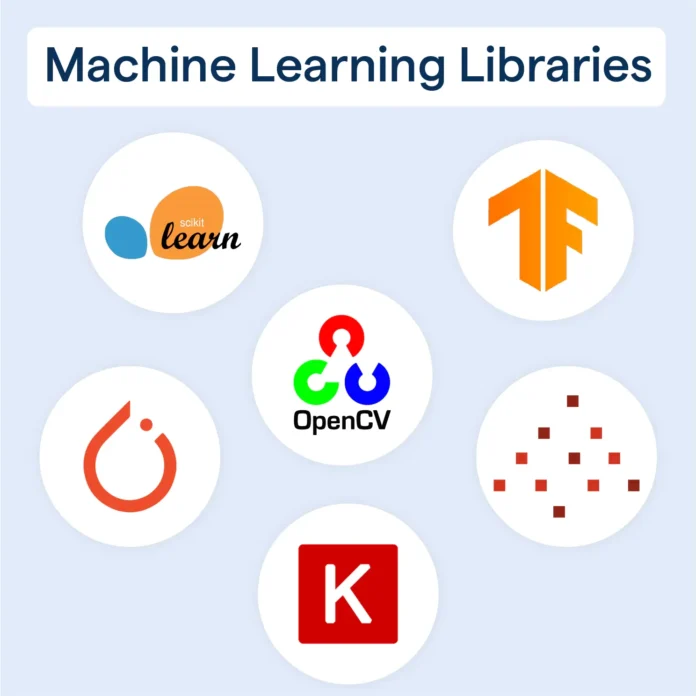In 2025, Python remains the undisputed powerhouse of machine learning. This dominance is hardly surprising. Its rich open-source library ecosystem covers every phase of the ML workflow—from lightning-fast data manipulation to enterprise-grade deep learning.
Notably, scikit-learn continues to be among the most popular machine learning libraries. It owes much of its relevance to seamless compatibility with NumPy, SciPy, and Matplotlib.
Meanwhile, other staples of the ecosystem also shine. PyTorch, renowned for its flexibility and ease of experimentation, remains a favourite in labs and R&D departments. At the same time, TensorFlow continues to lead in deployment scenarios and production environments.
What you’ll find in this guide?
If you’re exploring regression prototypes, optimizing feature pipelines, scaling neural networks, or experimenting with advanced auto-differentiation, this article is your roadmap.
1. NumPy – The Foundation of Scientific Computing
- What it does: NumPy provides efficient multi-dimensional array operations and mathematical functions—this functionality is central to ML data handling.
- Best for: Low-level numeric computing, laying the groundwork for data pipelines, and supporting most other ML libraries.
- Why it matters: NumPy is essential for performance-intensive tasks; moreover, it underpins popular tools like pandas and scikit-learn.
2. Pandas – Data Cleaning & Feature Engineering Made Simple
- What it does: Pandas offers high-level data structures (DataFrame, Series) that make structured data easy to manipulate.
- Best for: Data cleaning, exploration, transformation, and preparing datasets before modeling.
- Why it matters: Pandas makes preprocessing and analysis intuitive—especially for tabular datasets. In addition, most data scientists regard it as indispensable for data wrangling.
3. scikit-learn – Classic ML Toolkit
- What it does: scikit-learn supplies a rich collection of algorithms—from classification and regression to clustering—all with a clean and consistent API.
- Best for: Prototyping traditional ML workflows, such as random forests, SVMs, and dimensionality reduction.
- Why it matters: Its easy interface, comprehensive documentation, and reliable tools make it a standard choice for model building. Furthermore, it integrates seamlessly with the broader Python stack.
4. TensorFlow – Production-scaled Deep Learning
- What it does: Offers scalable training and deployment for neural networks across CPU, GPU, and TPU environments.
- Best for: Building and serving deep learning models in production, visualising models, and cross-platform deployment.
- Why it matters: Its flexibility, ecosystem, and tooling around model serving make it ideal for enterprise systems.
5. PyTorch – Research-friendly Deep Learning
- What it does: PyTorch uses dynamic computation graphs and an intuitive Pythonic interface for deep learning and research.
- Best for: Rapid prototyping, experimentation, and cutting-edge deep learning tasks such as vision and NLP.
- Why it matters: Its ease of debugging, strong adoption in research, and expansive ecosystem (torchvision, torchtext) make it a go-to for innovation. Indeed, it’s highly favored in both academia and industry labs.
6. JAX – Accelerated Array Computation & Differentiation
- What it does: JAX delivers fast, NumPy-compatible operations with automatic differentiation and built-in JIT compilation via XLA.
- Best for: GPU/TPU-accelerated scientific computing and advanced model experimentation.
- Why it matters: JAX combines performance with flexibility, making it ideal for high-performance numerical modeling and scalable research. Consequently, it’s gaining traction among advanced ML practitioners.
Quick Comparison Table
| Library | Core Strength | Ideal Use Case |
| NumPy | High-performance array ops | Foundational numeric computing |
| Pandas | Structured data manipulation | Cleaning, analyzing, organizing datasets |
| Scikit-learn | Versatile classical ML methods | Quick prototyping and traditional algorithms |
| TensorFlow | Production-grade deep learning + deployment tools | Scalable neural networks |
| PyTorch | Easy experimentation with dynamic graphs | Research and development of DL models |
| JAX | Fast, auto-diff, NumPy-like API | Accelerated mathematical modeling |
From bare array manipulation to deep learning at scale and bleeding-edge computational libraries, these six libraries drive the rest of your ML adventure in 2025. Leverage NumPy and pandas for building blocks and data prep, scikit-learn for rapid modelling, TensorFlow for deployment at scale, PyTorch for research agility, and JAX when speed and heavy computation are most important.





